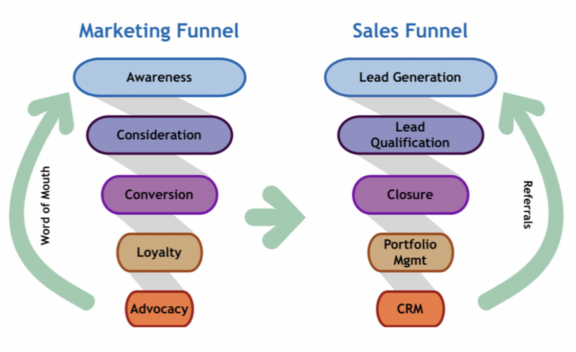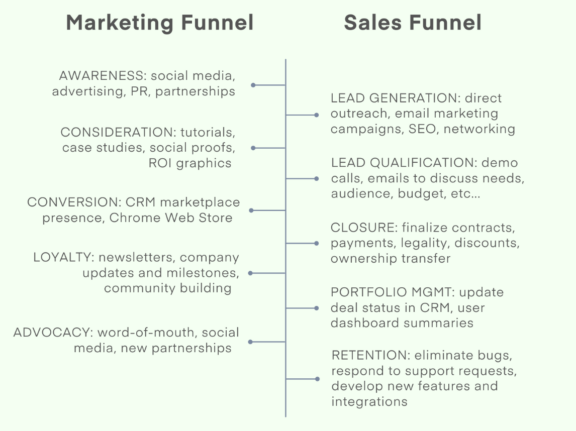Why you need both a marketing funnel template and a sales funnel template

Marketing and sales funnel template: Isolating your sales and marketing funnels can actually build synergy between the two.
As we all know, the goal of sales is converting leads to customers.
With that being said, marketing strategy and sales teams must work together in unison to do so. Fortunately, there are methodical approaches that can be applied to simultaneously guide prospects towards the end goal.
They are recognized as marketing funnels and sales funnels — made up of many stages that correspond to the various channels within the buying process. Marketing and sales funnels should work in tandem to encourage communication and interaction between teams. Still wondering why you need a sales funnel template? Keep reading!
Marketing funnels vs. Sales funnels
Funnels are used to move things from point A to point B in a continuous manner. Whether it be funneling concrete during construction or cake batter while cooking — the same goes for prospective customers in business.
Put simply, each funnel works side by side to guide leads through the sales cycle down unique, yet parallel avenues.
Imagine it like a game of ping pong, but at the end — both parties win if executed efficiently.
If you’re having a hard time visualizing this, take a look at the diagram below.

Source: Karen Newcombe
Too often, people assume that sales begins with lead generation and ends with conversion, but this couldn’t be further from the truth.
Technically speaking, yes — the sales funnel does involve lead generation and closing deals, but how does one generate leads without help from advertising or social media? How does one close a deal if the prospect is in limbo between multiple brands that offer a similar product?
This is where the marketing funnel comes into play.
Each stage of the marketing funnel generally precedes the corresponding stage of the sales funnel to establish momentum and propel leads towards the next step in their buying journey.
Businesses must create awareness to generate leads, establish credibility to qualify leads, initiate conversion to finalize closure, build loyalty to retain clients, and spread awareness to continue growing and evolving the brand.
As you can see, the marketing team plays an integral role in nourishing and sustaining the sales process.
Through combined efforts, each team is more likely to avoid missed opportunities and unnecessary churns while creating a positive feedback loop for business activities.
Why do you need a marketing funnel?
The purchasing process is no longer linear, and collaboration between marketing and sales teams is critical to the success of any business endeavor.
We are living through the Phygital Era — meaning that business transactions take place both physically and digitally.
This requires companies to adopt a multichannel approach if they want to attack consumers from all angles.
By synchronizing sales and marketing efforts, teams will inevitably increase the number of inbound and outbound leads.
For example, you may have a lot of traffic coming to your website but very few people signing up to participate in a demo. Maybe it’s because your Call To Action (CTA) is not centralized on the page, or maybe it’s because your wording choice is catering to the wrong audience.
By mapping the customer journey through the combination of these funnels, you can isolate each step of the process to better understand where losses are being made or where there is room to elevate your performance.
You can then focus on finding creative outlets to make your business strategy far more lucrative.
How to build a marketing funnel for your brand?
Remember, every business strategy is unique and your marketing funnel diagrams and sales funnel diagrams will vary in terms of size and complexity depending on the nature of your business.
We suggest that you draft multiple funnels composed of relevant and actionable steps within each category.
Once you identify the funnels that yield the highest conversion rates, repeat the process. Don’t be afraid to eliminate channels that show little to no ROI.
There are many sales and marketing funnel templates that can be used as references to help you map out your customer journey.
Here is an example of one that we use at Surfe…

Source: Surfe
This draft was made through trial and error. We are always experimenting with new channels.
Bottom line
If you’re not sure where to begin, try reading through these 5 productivity hacks. They will advise you on how to optimize your workflow, build a roadmap, develop SMART value metrics, and take advantage of tools that might be helpful in doing so.
Good luck!


